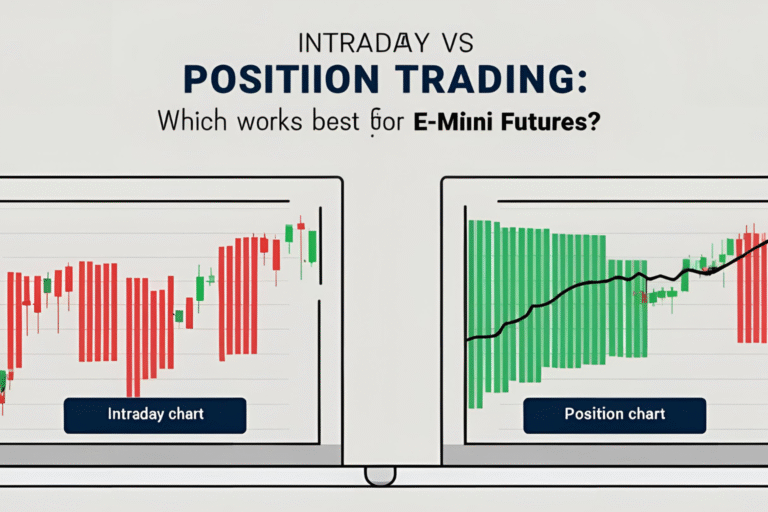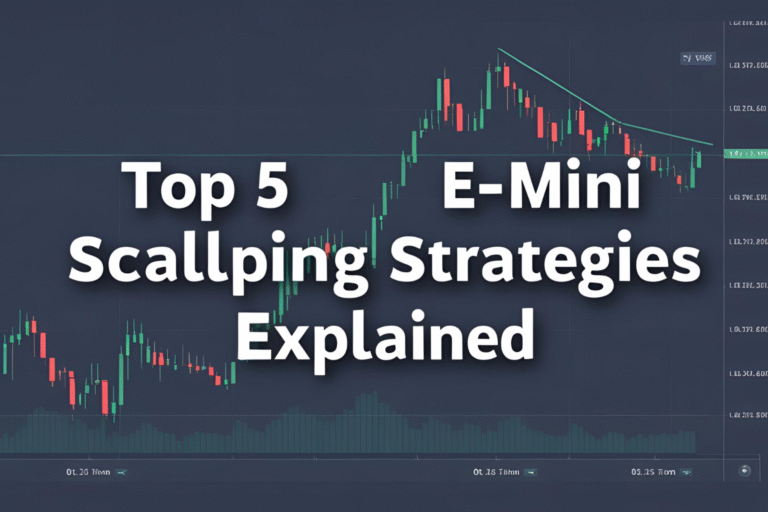Swing Trading E-mini S&P 500 Futures: Step-by-Step
If you don’t have time to monitor charts minute-by-minute, swing trading E-mini futures could be your ideal approach. Unlike scalping or intraday trading, swing trading targets multi-day moves for larger profits with fewer trades.
This guide walks you through a step-by-step E-mini swing trading method suited for Indian beginners using E-mini (ES) or Micro E-mini (MES) contracts.
What Is Swing Trading?
Swing trading involves holding positions for several days to capture short- to medium-term trends. It allows you to:
- Trade less frequently
- Avoid noise from minute-by-minute price movements
- Combine technical and macro analysis
- Trade after U.S. market closes (ideal for Indian traders)
Why Swing Trade E-mini S&P 500 Futures?
- High liquidity: Smooth order execution even for larger positions
- 24-hour trading: Flexibility for Indian time zones
- Trending nature: S&P 500 often moves in sustained waves
- Capital efficiency: Use leverage with lower capital compared to stocks
Step-by-Step Swing Trading Strategy
✅ Step 1: Use a Higher Timeframe Chart
- Focus on 4-hour or Daily charts
- Identify major support and resistance zones
- Use candlestick confirmation near zones to plan entries
✅ Step 2: Choose Indicators for Trend Confirmation
Use these three together for more confidence:
- 50 EMA – shows medium-term trend direction
- MACD – confirms momentum
- ATR – estimates average volatility for stop-loss setting
Entry Filter:
- Price above 50 EMA + MACD bullish crossover = long setup
- Price below 50 EMA + MACD bearish crossover = short setup
✅ Step 3: Plan Entry and Stop-Loss
Entry: Place limit orders near breakouts or pullbacks
Stop-loss: Use 1.5x ATR to define a smart stop level
Example:
- If ATR (14) on the 4H chart is 12 points
- Stop-loss = 12 × 1.5 = 18 points
Always use a fixed reward-to-risk ratio (target at least 2:1)
✅ Step 4: Set Target Zones
Use one or more of these to define exits:
- Previous swing high/low
- Fibonacci retracement extensions (e.g., 127%, 161.8%)
- Major round numbers (e.g., 4500, 4550)
You can also scale out:
- Exit 50% at 1:1
- Exit the rest at 2:1 or trailing stop
✅ Step 5: Trade Management
- Avoid checking charts constantly; let your trade play out
- Use alerts to monitor price at key levels
- Review every trade using a swing trading journal
Example Trade Setup
| Criteria | Value |
|---|---|
| Contract | E-mini S&P 500 (ES) |
| Timeframe | 4H |
| Trend | Bullish |
| Entry | Breakout above 4525 |
| Stop-loss | 4507 (ATR-based) |
| Target | 4560 (risk-reward 1:2) |
Tips for Indian Swing Traders
- Best time to analyze charts: Early morning (6–8 AM IST) before U.S. pre-market
- Use Micro E-mini (MES) to test setups first
- Avoid overtrading—2–3 swing trades/week is plenty
- Focus on quality setups, not quantity
Tools for Swing Trading
| Tool | Purpose |
|---|---|
| TradingView | Chart analysis & alerts |
| Interactive Brokers TWS | Trade execution |
| Finviz or Investing.com | U.S. stock index news |
| Economic Calendar | Avoid high-impact news near entry points |
| MyFXBook / Edgewonk | Trade journaling and analysis |
Final Thoughts
Swing trading E-mini S&P 500 futures is perfect if you’re a beginner with limited time. It reduces stress, allows analysis in off-hours, and gives you a chance to learn market structure deeply.
Master one swing system, log your trades, and build consistency. Over time, you can scale from Micro to full E-mini contracts.
FAQs
Q1. What’s the best timeframe for swing trading E-mini?
The 4-hour and daily charts are most reliable for swing setups.
Q2. Is swing trading suitable for part-time traders?
Yes. You only need 15–30 minutes/day to manage swing trades.
Q3. Can I hold E-mini futures overnight?
Yes. But check your broker’s margin and overnight funding rules.
Q4. Do I need news analysis for swing trades?
Basic macro awareness helps. Avoid entering near major U.S. events like Fed announcements or CPI data.
Q5. What if I miss a trade setup?
Don’t chase it. Wait for a fresh signal—swing trading is about patience and timing.



